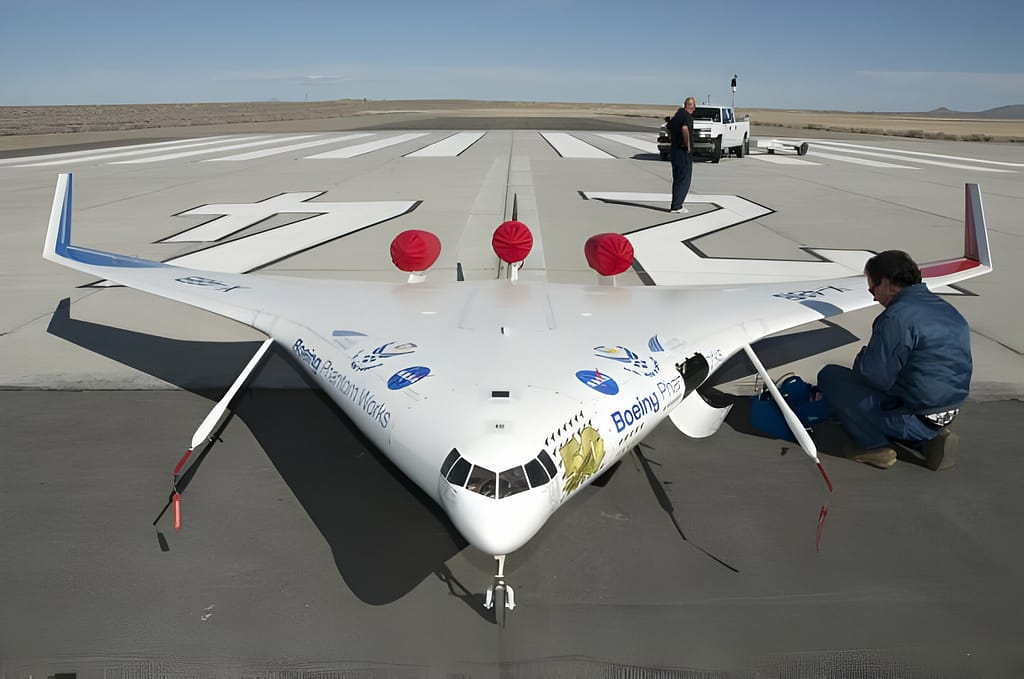In a significant step forward, Aurora Flight Sciences, a subsidiary of Boeing, has initiated the manufacturing process for DARPA’s experimental X-65 aircraft. The aircraft is a key component of the Defense Advanced Research Projects Agency’s (DARPA) Control of Revolutionary Aircraft with Novel Effectors (CRANE) program, aiming to demonstrate the capabilities of Active Flow Control (AFC) in aviation.
Table of Contents
Advancing Active Flow Control Technology
Following the successful completion of the critical design review (CDR), Aurora Flight Sciences has entered the manufacturing phase for the X-65 test plane. This experimental aircraft is specifically designed for testing and showcasing Active Flow Control (AFC) across various effects, including tactical flight control and performance enhancement. AFC has the potential to revolutionize aircraft design by eliminating traditional jointed surfaces such as rudders, ailerons, flaps, and canards, which contribute to increased weight and mechanical complexity.
AFC System Configuration and Modular Design
The X-65 incorporates an AFC system that supplies pressurized air to fourteen AFC effectors strategically embedded across all flying surfaces, including multiple wing sweeps. Notably, the aircraft is designed with modularity in mind, featuring replaceable outboard wings and swappable AFC effectors. This design approach allows for future testing and exploration of additional AFC configurations, enhancing flexibility in design trade space for both military and commercial applications.

Potential Benefits for Commercial and Military Aviation
Active Flow Control technology holds the promise of replacing conventional flaps and rudders used in maneuvering most aircraft today. By potentially improving aerodynamics, reducing weight, and simplifying mechanical systems, AFC could deliver substantial benefits for both commercial and military aviation. The X-65 is positioned to serve as a demonstrator, showcasing the advantages of AFC and paving the way for its integration into future aircraft designs.
Milestones in Manufacturing and Testing
Component tooling and part fabrication for the X-65’s 30 ft wingspan are currently underway at Aurora facilities in West Virginia and Mississippi. The comprehensive plan includes building the airframe at Aurora’s West Virginia location, with system integration and ground testing taking place at the company’s headquarters in Manassas, Virginia. The program is set to culminate in flight tests of the full-scale, 7000 lb. X-65 aircraft, with anticipated speeds reaching up to Mach 0.7. The targeted timeframe for these flight tests is the summer of 2025.
Aurora’s Continued Involvement with DARPA
This endeavor follows Aurora Flight Sciences’ selection for phase 1 of another DARPA X-plane project, the SPeed and Runway INdependent Technologies (SPRINT). Alongside Bell Textron, Inc., Northrop Grumman Aeronautic Systems, and Piasecki Aircraft Corporation, Aurora is contributing to the conceptual designs for the SPRINT program. SPRINT aims to develop an X-plane that demonstrates technologies facilitating a transformative combination of aircraft speed and runway independence.
Under the SPRINT project, Aurora is engaged in designing a high-lift, low-drag fan-in-wing (FIW) demonstrator aircraft. This aircraft integrates a blended wing body platform with embedded engines and moderate sweep, along with a vertical flight design featuring embedded lift fans. The goal is to achieve game-changing air mobility capability by seamlessly combining high-speed cruise with vertical takeoff and landing (VTOL) within a single platform.
Leveraging Expertise for Transformational Flight
Aurora and Boeing, collectively contributing deep expertise in agile vehicle prototyping, vertical lift, and cruise transition technology, and blended wing body aerodynamics, aim to build on past successes. Previous flight programs, such as the Boeing X-48 blended wing body aircraft and the Aurora Excalibur UAS, serve as foundations for the current project. The program’s design work spans multiple states, including Virginia, Massachusetts, and Pennsylvania, with the first flight of the X-Plane demonstrator anticipated within 42 months.
Aurora Flight Sciences’ commitment to advancing revolutionary aircraft technologies reflects a pivotal moment in the evolution of aviation. The X-65 and SPRINT projects position the company at the forefront of shaping the future of air mobility and aircraft design, with implications for both military and commercial applications.